DODGE VIPER SRT 2016 VX / 3.G Repair Manual
Manufacturer: DODGE, Model Year: 2016, Model line: VIPER SRT, Model: DODGE VIPER SRT 2016 VX / 3.GPages: 427, PDF Size: 3.02 MB
Page 61 of 427
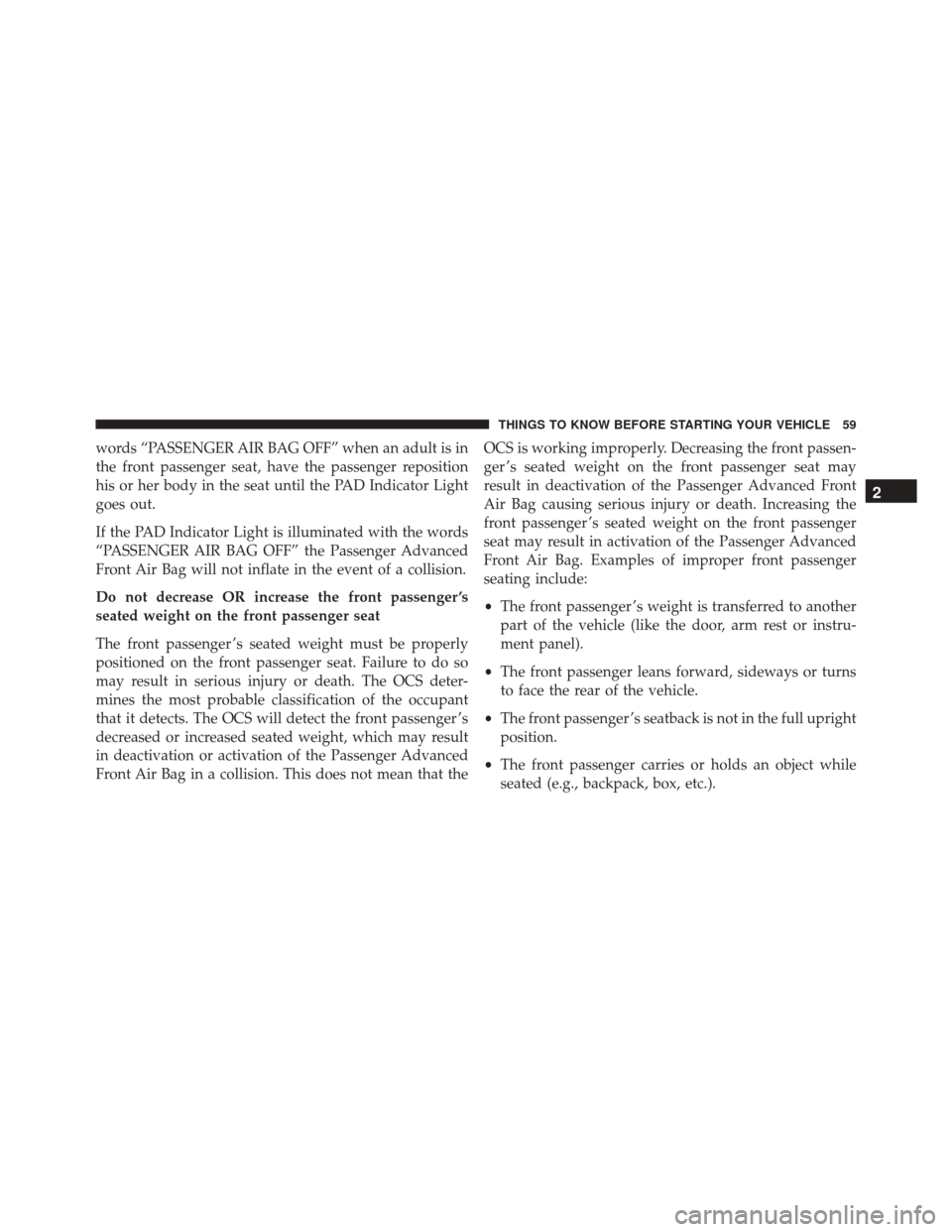
words “PASSENGER AIR BAG OFF” when an adult is in
the front passenger seat, have the passenger reposition
his or her body in the seat until the PAD Indicator Light
goes out.
If the PAD Indicator Light is illuminated with the words
“PASSENGER AIR BAG OFF” the Passenger Advanced
Front Air Bag will not inflate in the event of a collision.
Do not decrease OR increase the front passenger ’s
seated weight on the front passenger seat
The front passenger ’s seated weight must be properly
positioned on the front passenger seat. Failure to do so
may result in serious injury or death. The OCS deter-
mines the most probable classification of the occupant
that it detects. The OCS will detect the front passenger ’s
decreased or increased seated weight, which may result
in deactivation or activation of the Passenger Advanced
Front Air Bag in a collision. This does not mean that theOCS is working improperly. Decreasing the front passen-
ger ’s seated weight on the front passenger seat may
result in deactivation of the Passenger Advanced Front
Air Bag causing serious injury or death. Increasing the
front passenger ’s seated weight on the front passenger
seat may result in activation of the Passenger Advanced
Front Air Bag. Examples of improper front passenger
seating include:
•
The front passenger ’s weight is transferred to another
part of the vehicle (like the door, arm rest or instru-
ment panel).
• The front passenger leans forward, sideways or turns
to face the rear of the vehicle.
• The front passenger ’s seatback is not in the full upright
position.
• The front passenger carries or holds an object while
seated (e.g., backpack, box, etc.).
2
THINGS TO KNOW BEFORE STARTING YOUR VEHICLE 59
Page 62 of 427
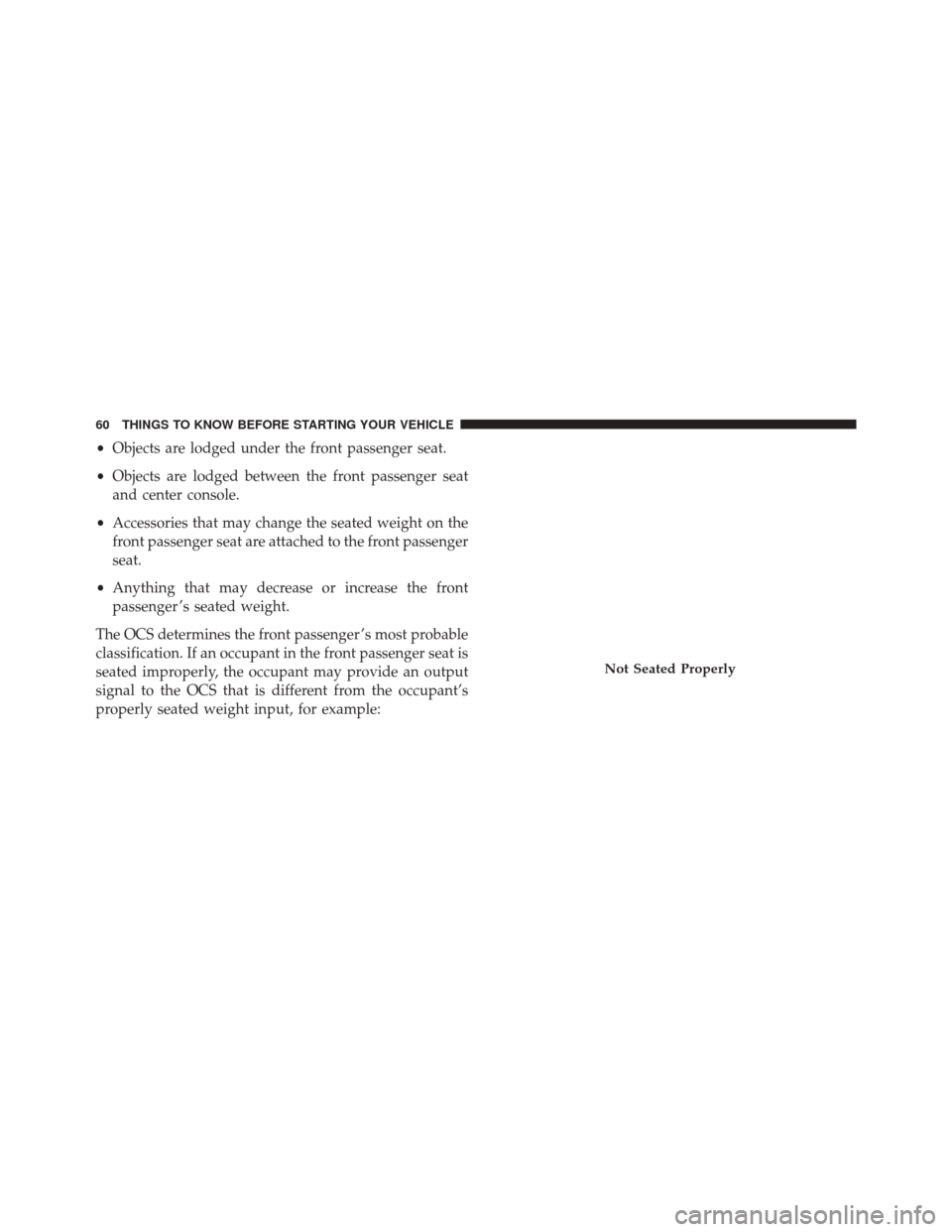
•Objects are lodged under the front passenger seat.
• Objects are lodged between the front passenger seat
and center console.
• Accessories that may change the seated weight on the
front passenger seat are attached to the front passenger
seat.
• Anything that may decrease or increase the front
passenger ’s seated weight.
The OCS determines the front passenger ’s most probable
classification. If an occupant in the front passenger seat is
seated improperly, the occupant may provide an output
signal to the OCS that is different from the occupant’s
properly seated weight input, for example:
Not Seated Properly
60 THINGS TO KNOW BEFORE STARTING YOUR VEHICLE
Page 63 of 427
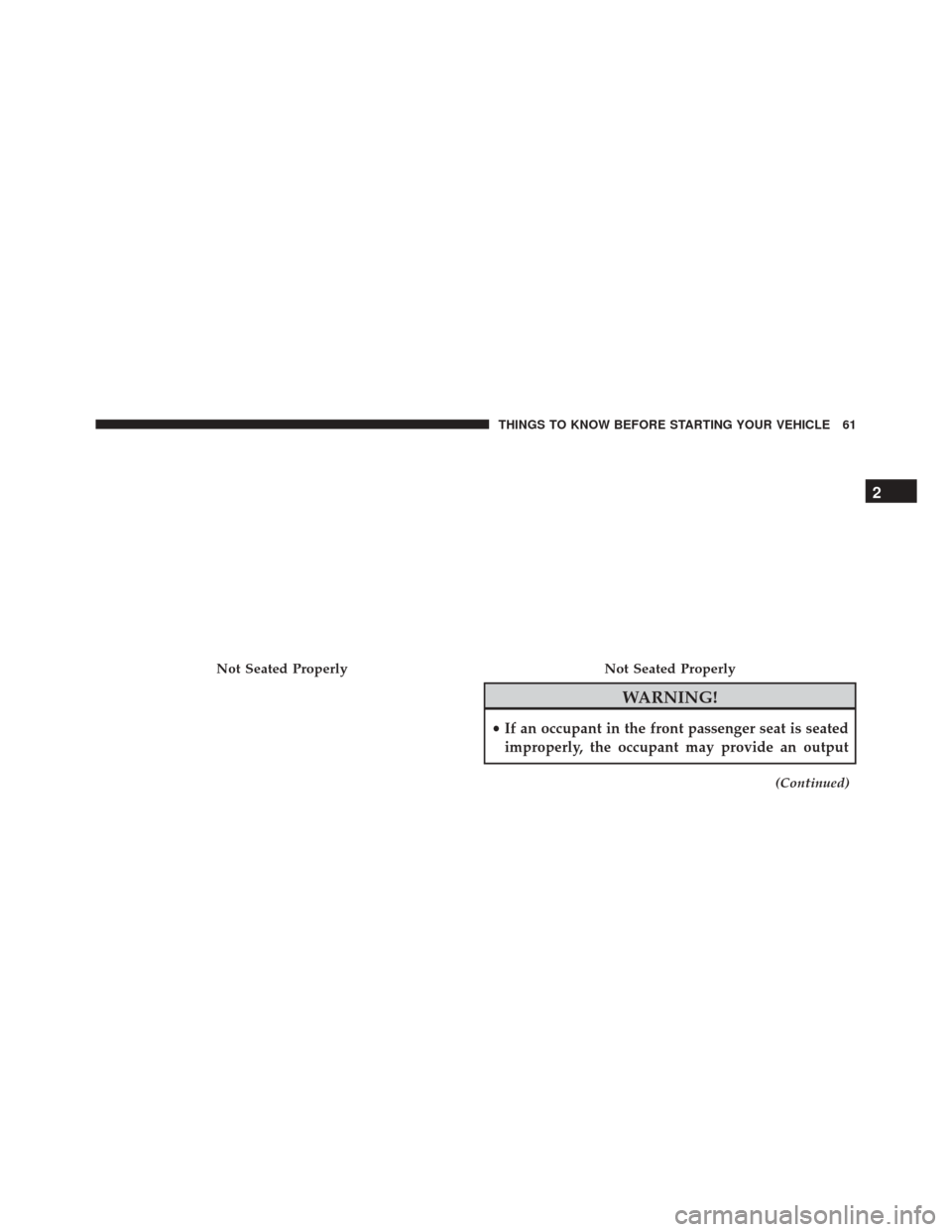
WARNING!
•If an occupant in the front passenger seat is seated
improperly, the occupant may provide an output
(Continued)
Not Seated ProperlyNot Seated Properly
2
THINGS TO KNOW BEFORE STARTING YOUR VEHICLE 61
Page 64 of 427
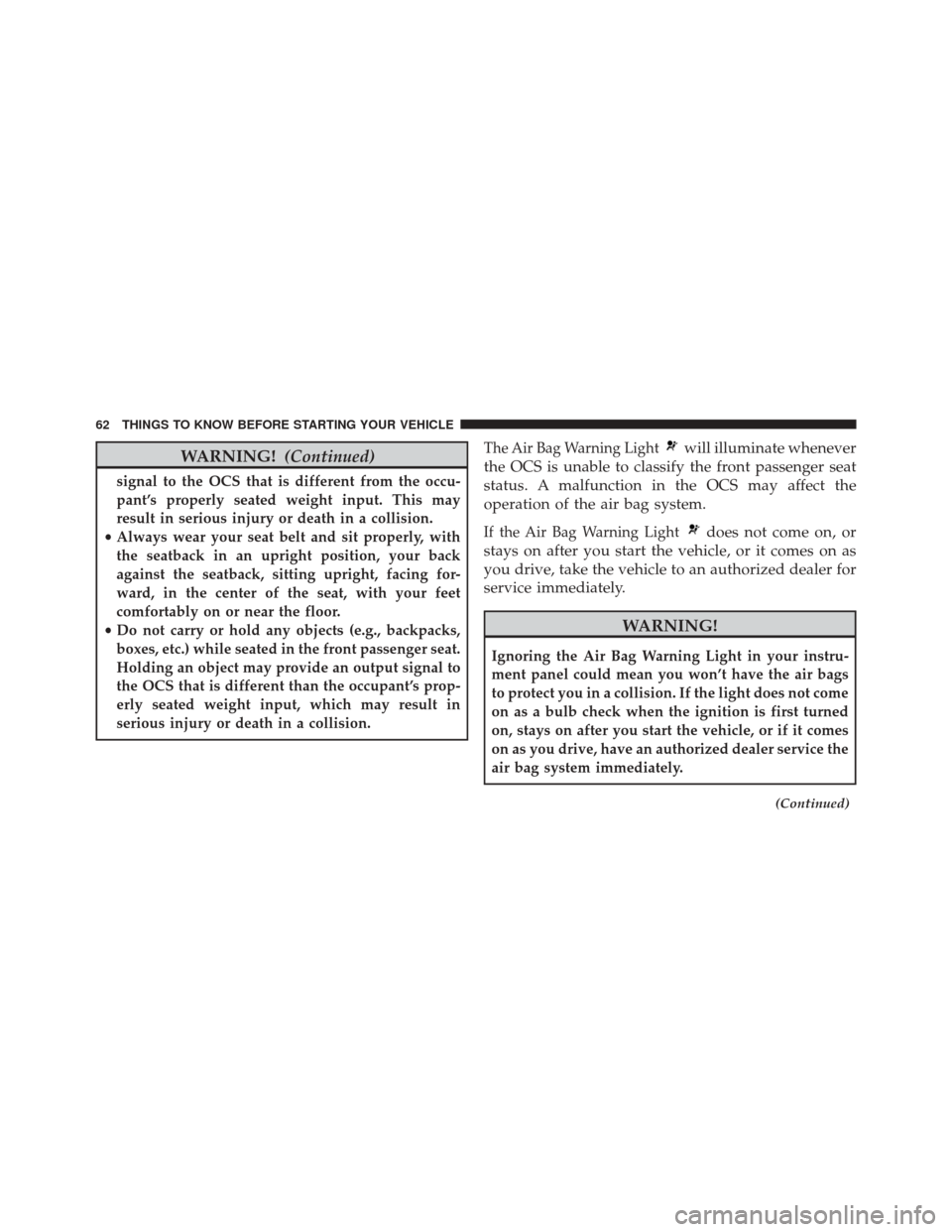
WARNING!(Continued)
signal to the OCS that is different from the occu-
pant’s properly seated weight input. This may
result in serious injury or death in a collision.
• Always wear your seat belt and sit properly, with
the seatback in an upright position, your back
against the seatback, sitting upright, facing for-
ward, in the center of the seat, with your feet
comfortably on or near the floor.
• Do not carry or hold any objects (e.g., backpacks,
boxes, etc.) while seated in the front passenger seat.
Holding an object may provide an output signal to
the OCS that is different than the occupant’s prop-
erly seated weight input, which may result in
serious injury or death in a collision. The Air Bag Warning Light
will illuminate whenever
the OCS is unable to classify the front passenger seat
status. A malfunction in the OCS may affect the
operation of the air bag system.
If the Air Bag Warning Lightdoes not come on, or
stays on after you start the vehicle, or it comes on as
you drive, take the vehicle to an authorized dealer for
service immediately.
WARNING!
Ignoring the Air Bag Warning Light in your instru-
ment panel could mean you won’t have the air bags
to protect you in a collision. If the light does not come
on as a bulb check when the ignition is first turned
on, stays on after you start the vehicle, or if it comes
on as you drive, have an authorized dealer service the
air bag system immediately.
(Continued)
62 THINGS TO KNOW BEFORE STARTING YOUR VEHICLE
Page 65 of 427
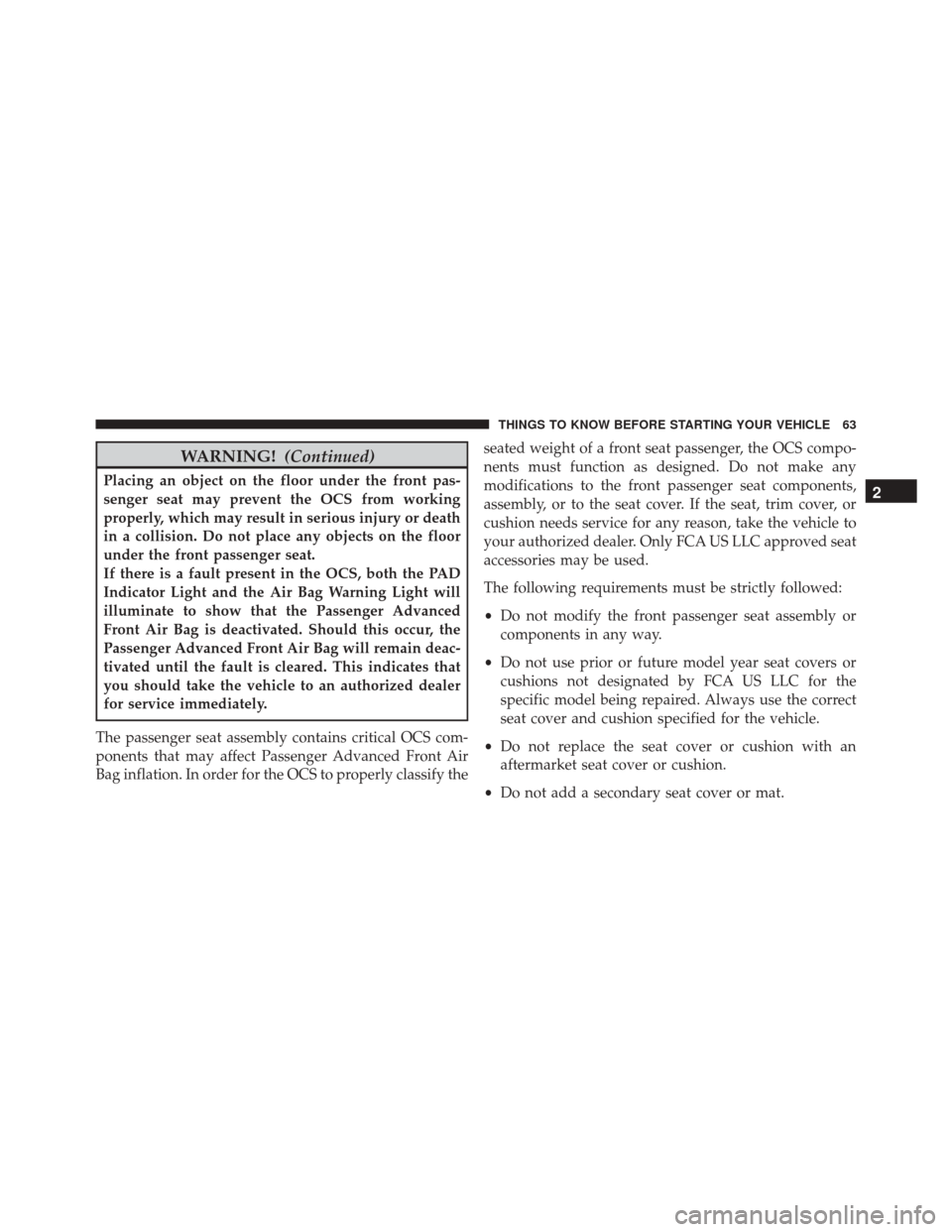
WARNING!(Continued)
Placing an object on the floor under the front pas-
senger seat may prevent the OCS from working
properly, which may result in serious injury or death
in a collision. Do not place any objects on the floor
under the front passenger seat.
If there is a fault present in the OCS, both the PAD
Indicator Light and the Air Bag Warning Light will
illuminate to show that the Passenger Advanced
Front Air Bag is deactivated. Should this occur, the
Passenger Advanced Front Air Bag will remain deac-
tivated until the fault is cleared. This indicates that
you should take the vehicle to an authorized dealer
for service immediately.
The passenger seat assembly contains critical OCS com-
ponents that may affect Passenger Advanced Front Air
Bag inflation. In order for the OCS to properly classify the seated weight of a front seat passenger, the OCS compo-
nents must function as designed. Do not make any
modifications to the front passenger seat components,
assembly, or to the seat cover. If the seat, trim cover, or
cushion needs service for any reason, take the vehicle to
your authorized dealer. Only FCA US LLC approved seat
accessories may be used.
The following requirements must be strictly followed:
•
Do not modify the front passenger seat assembly or
components in any way.
• Do not use prior or future model year seat covers or
cushions not designated by FCA US LLC for the
specific model being repaired. Always use the correct
seat cover and cushion specified for the vehicle.
• Do not replace the seat cover or cushion with an
aftermarket seat cover or cushion.
• Do not add a secondary seat cover or mat.2
THINGS TO KNOW BEFORE STARTING YOUR VEHICLE 63
Page 66 of 427
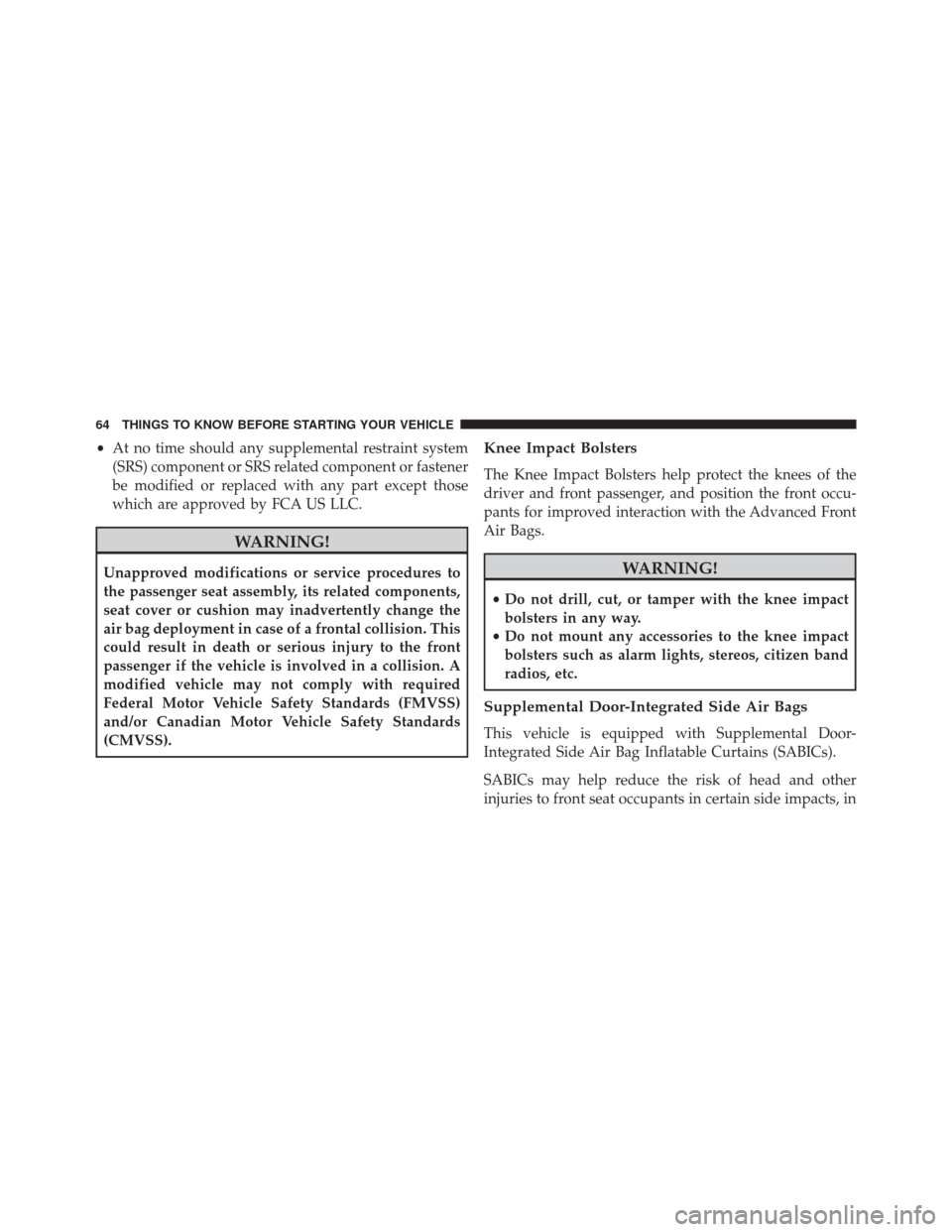
•At no time should any supplemental restraint system
(SRS) component or SRS related component or fastener
be modified or replaced with any part except those
which are approved by FCA US LLC.
WARNING!
Unapproved modifications or service procedures to
the passenger seat assembly, its related components,
seat cover or cushion may inadvertently change the
air bag deployment in case of a frontal collision. This
could result in death or serious injury to the front
passenger if the vehicle is involved in a collision. A
modified vehicle may not comply with required
Federal Motor Vehicle Safety Standards (FMVSS)
and/or Canadian Motor Vehicle Safety Standards
(CMVSS).
Knee Impact Bolsters
The Knee Impact Bolsters help protect the knees of the
driver and front passenger, and position the front occu-
pants for improved interaction with the Advanced Front
Air Bags.
WARNING!
• Do not drill, cut, or tamper with the knee impact
bolsters in any way.
• Do not mount any accessories to the knee impact
bolsters such as alarm lights, stereos, citizen band
radios, etc.
Supplemental Door-Integrated Side Air Bags
This vehicle is equipped with Supplemental Door-
Integrated Side Air Bag Inflatable Curtains (SABICs).
SABICs may help reduce the risk of head and other
injuries to front seat occupants in certain side impacts, in
64 THINGS TO KNOW BEFORE STARTING YOUR VEHICLE
Page 67 of 427
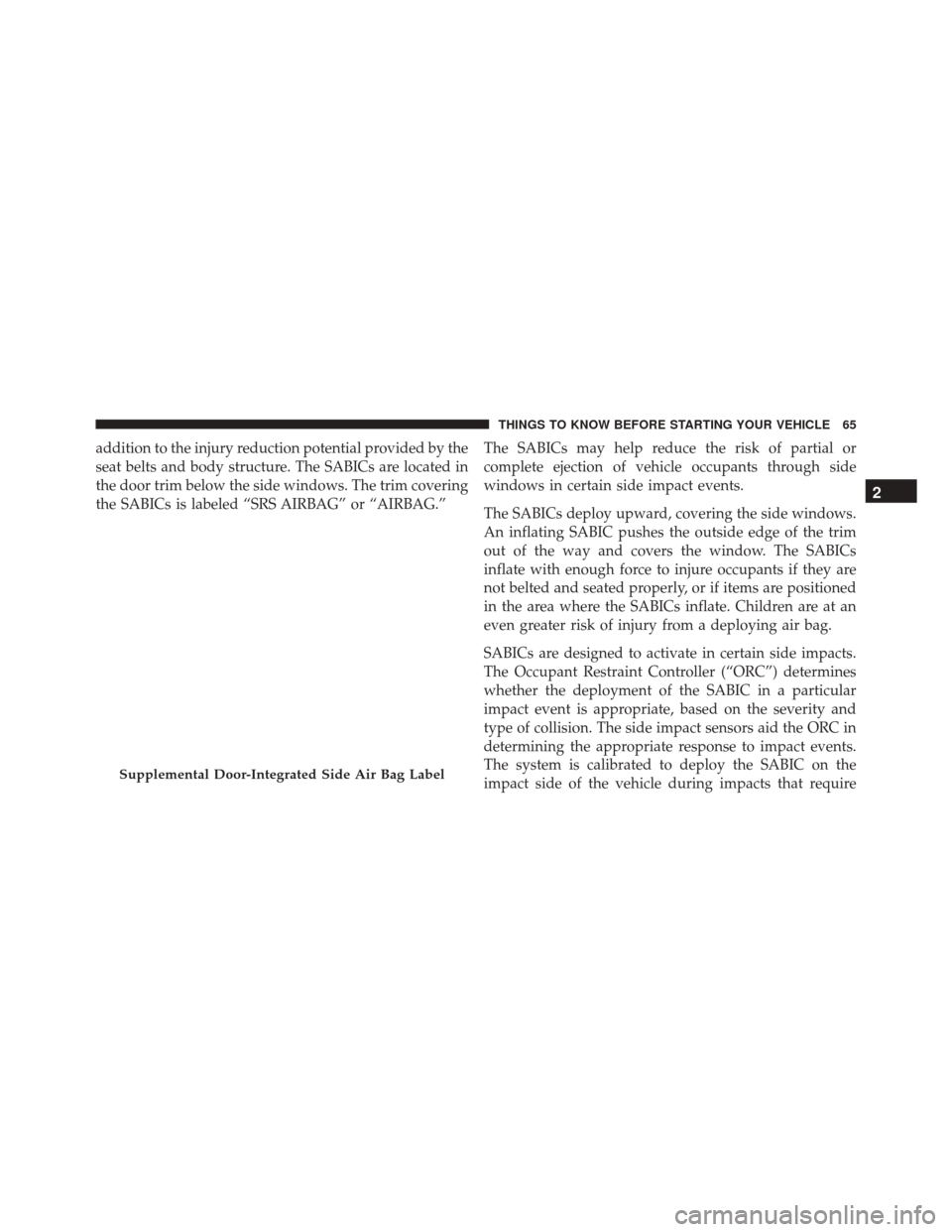
addition to the injury reduction potential provided by the
seat belts and body structure. The SABICs are located in
the door trim below the side windows. The trim covering
the SABICs is labeled “SRS AIRBAG” or “AIRBAG.”The SABICs may help reduce the risk of partial or
complete ejection of vehicle occupants through side
windows in certain side impact events.
The SABICs deploy upward, covering the side windows.
An inflating SABIC pushes the outside edge of the trim
out of the way and covers the window. The SABICs
inflate with enough force to injure occupants if they are
not belted and seated properly, or if items are positioned
in the area where the SABICs inflate. Children are at an
even greater risk of injury from a deploying air bag.
SABICs are designed to activate in certain side impacts.
The Occupant Restraint Controller (“ORC”) determines
whether the deployment of the SABIC in a particular
impact event is appropriate, based on the severity and
type of collision. The side impact sensors aid the ORC in
determining the appropriate response to impact events.
The system is calibrated to deploy the SABIC on the
impact side of the vehicle during impacts that require
Supplemental Door-Integrated Side Air Bag Label
2
THINGS TO KNOW BEFORE STARTING YOUR VEHICLE 65
Page 68 of 427
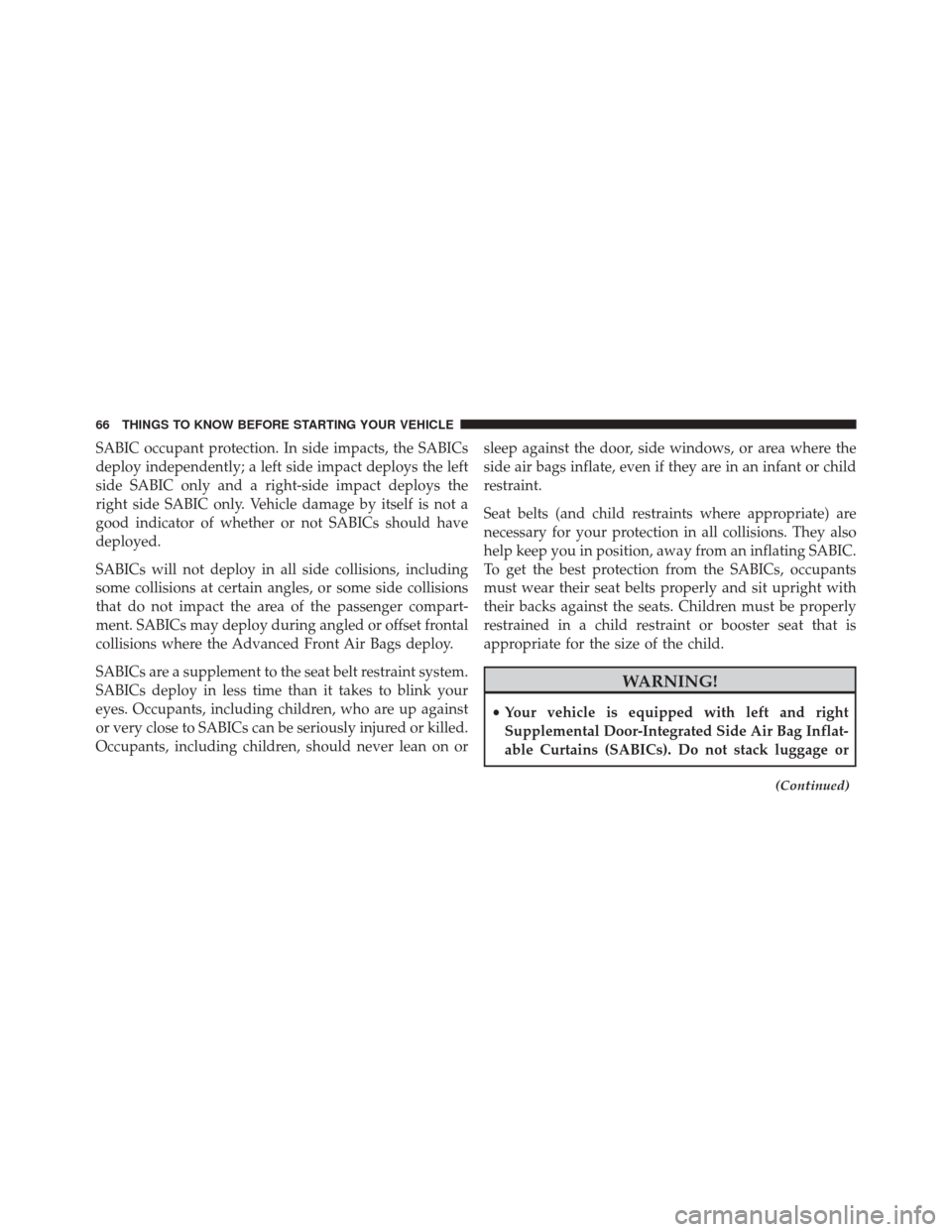
SABIC occupant protection. In side impacts, the SABICs
deploy independently; a left side impact deploys the left
side SABIC only and a right-side impact deploys the
right side SABIC only. Vehicle damage by itself is not a
good indicator of whether or not SABICs should have
deployed.
SABICs will not deploy in all side collisions, including
some collisions at certain angles, or some side collisions
that do not impact the area of the passenger compart-
ment. SABICs may deploy during angled or offset frontal
collisions where the Advanced Front Air Bags deploy.
SABICs are a supplement to the seat belt restraint system.
SABICs deploy in less time than it takes to blink your
eyes. Occupants, including children, who are up against
or very close to SABICs can be seriously injured or killed.
Occupants, including children, should never lean on orsleep against the door, side windows, or area where the
side air bags inflate, even if they are in an infant or child
restraint.
Seat belts (and child restraints where appropriate) are
necessary for your protection in all collisions. They also
help keep you in position, away from an inflating SABIC.
To get the best protection from the SABICs, occupants
must wear their seat belts properly and sit upright with
their backs against the seats. Children must be properly
restrained in a child restraint or booster seat that is
appropriate for the size of the child.
WARNING!
•
Your vehicle is equipped with left and right
Supplemental Door-Integrated Side Air Bag Inflat-
able Curtains (SABICs). Do not stack luggage or
(Continued)
66 THINGS TO KNOW BEFORE STARTING YOUR VEHICLE
Page 69 of 427

WARNING!(Continued)
other cargo up high enough to block the deploy-
ment of the SABICs. The door trim below the side
windows where the SABIC and its deployment
path are located, should remain free from any
obstructions.
• SABICs need room to inflate. Do not lean against
the door or window. Sit upright in the center of the
seat.
• Being too close to the SABICs during deployment
could cause you to be severely injured or killed.
• Relying on the SABICs alone could lead to more
severe injuries in a collision. The SABICs work
with your seat belt to restrain you properly. In
some collisions, SABICs won’t deploy at all. Al-
ways wear your seat belt even though you have
SABICs. NOTE:
Air bag covers may not be obvious to you, but
they will open during air bag deployment.If A Deployment Occurs
The Advanced Front Air Bags are designed to deflate
immediately after deployment.
NOTE: Front and/or side air bags will not deploy in all
collisions. This does not mean something is wrong with
the air bag system.
If you do have a collision which deploys the air bags, any
or all of the following may occur:
• The air bag material may sometimes cause abrasions
and/or skin reddening to the occupants as the air bags
deploy and unfold. The abrasions are similar to fric-
tion rope burns or those you might get sliding along a
carpet or gymnasium floor. They are not caused by
contact with chemicals. They are not permanent and
2
THINGS TO KNOW BEFORE STARTING YOUR VEHICLE 67
Page 70 of 427
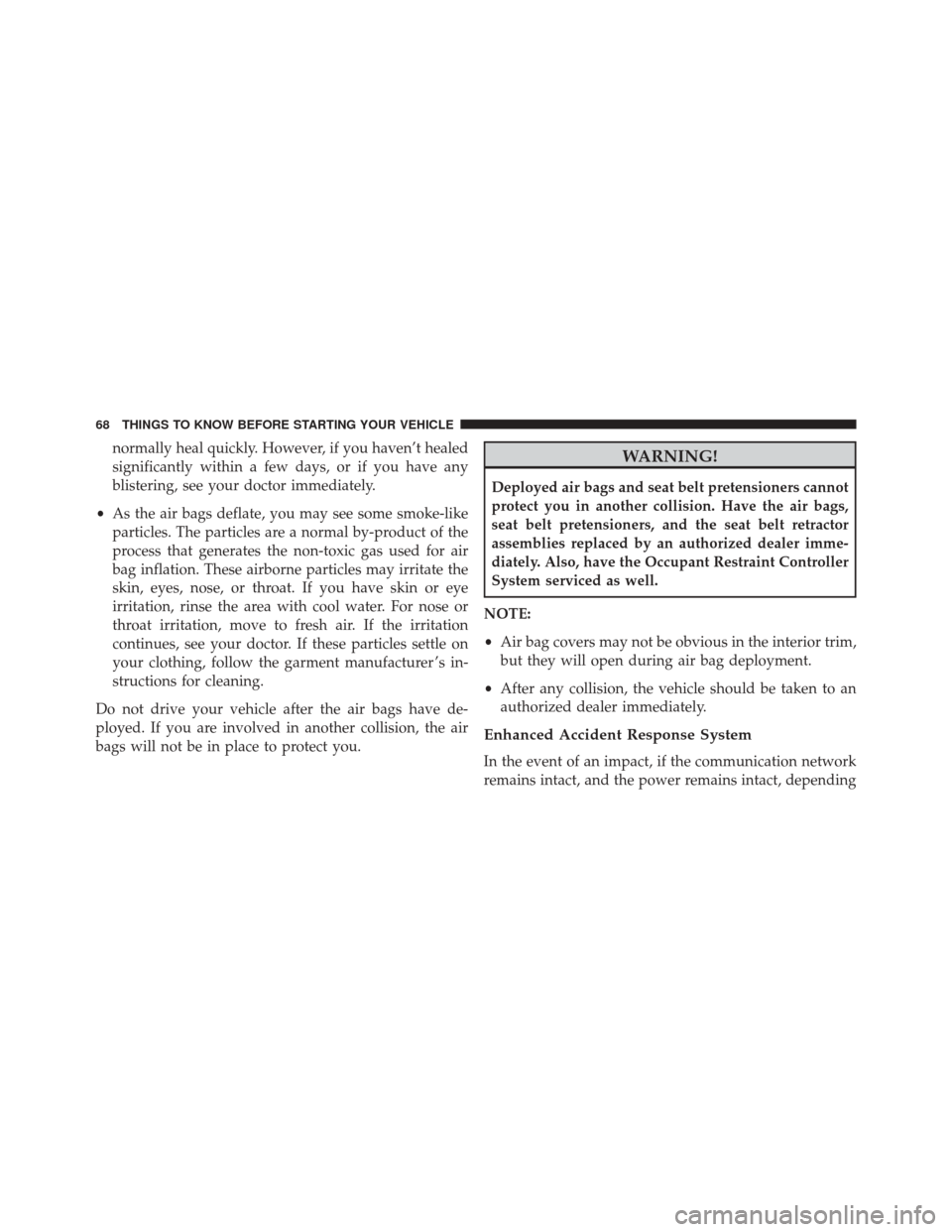
normally heal quickly. However, if you haven’t healed
significantly within a few days, or if you have any
blistering, see your doctor immediately.
• As the air bags deflate, you may see some smoke-like
particles. The particles are a normal by-product of the
process that generates the non-toxic gas used for air
bag inflation. These airborne particles may irritate the
skin, eyes, nose, or throat. If you have skin or eye
irritation, rinse the area with cool water. For nose or
throat irritation, move to fresh air. If the irritation
continues, see your doctor. If these particles settle on
your clothing, follow the garment manufacturer ’s in-
structions for cleaning.
Do not drive your vehicle after the air bags have de-
ployed. If you are involved in another collision, the air
bags will not be in place to protect you.WARNING!
Deployed air bags and seat belt pretensioners cannot
protect you in another collision. Have the air bags,
seat belt pretensioners, and the seat belt retractor
assemblies replaced by an authorized dealer imme-
diately. Also, have the Occupant Restraint Controller
System serviced as well.
NOTE:
• Air bag covers may not be obvious in the interior trim,
but they will open during air bag deployment.
• After any collision, the vehicle should be taken to an
authorized dealer immediately.
Enhanced Accident Response System
In the event of an impact, if the communication network
remains intact, and the power remains intact, depending
68 THINGS TO KNOW BEFORE STARTING YOUR VEHICLE